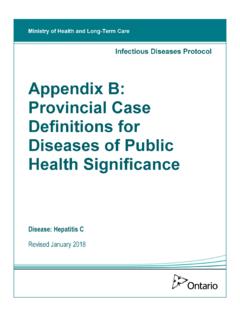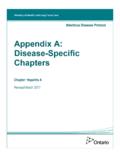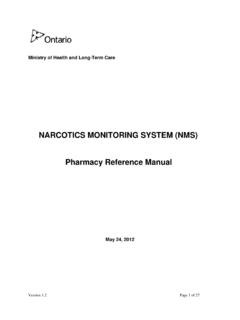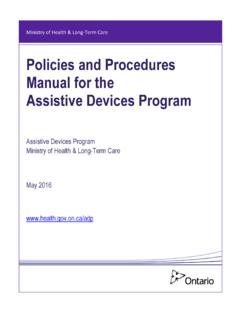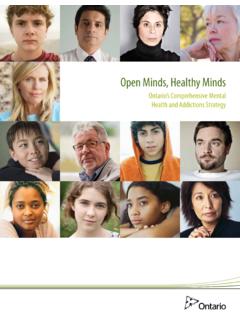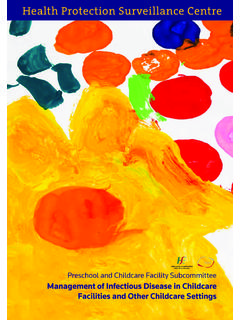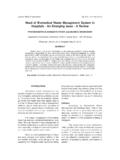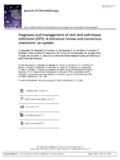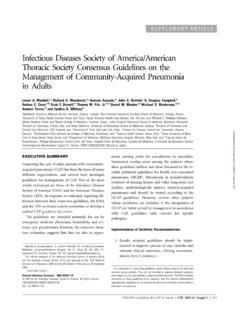Transcription of Appendix A: Disease-Specific Chapters
1 infectious Diseases Protocol Appendix A: Disease-Specific Chapters chapter : Measles Revised August 2014 2 Measles Communicable Virulent Health Protection and Promotion Act: Ontario Regulation 558/91 Specification of Communicable Diseases Health Protection and Promotion Act: Ontario Regulation 559/91 Specification of Reportable Diseases Aetiologic Agent Measles is caused by the measles virus, a member of the genus Morbillivirus of the family Case Definition Surveillance Case Definition See Appendix B.
2 Measles is eliminated in Canada; therefore, one case is unexpected. Public health units should notify PHO, as specified by the ministry, via telephone when there is a strong degree of clinical and epidemiological suspicion of measles ( travel history in an unimmunized person with clinically compatible signs and symptoms), even if laboratory confirmation is pending. Identification Clinical Presentation Symptoms of measles begin 7 18 days after exposure to a case of measles and include fever, runny nose (coryza), cough, drowsiness, irritability and red eyes (conjunctivitis).
3 Small white spots (known as "Koplik's spots") can appear on the inside of the mouth and throat, but are not always present. Then, 3 7 days after the start of the symptoms, a red blotchy (maculopapular) rash appears on the face and then progresses down the body. Complications include diarrhea, pneumonia, blindness and infections of the Complications such as otitis media and bronchopneumonia occur in about 10% of reported cases. Measles encephalitis occurs in approximately 1 of every 1,000 reported cases and may result in permanent brain damage.
4 Measles infection can cause subacute sclerosing panencephalitis (SSPE), a rare but fatal disease . Measles complications disproportionately affect persons suffering from malnutrition, immunodeficiency and pregnant 3 Diagnosis See Appendix B for diagnostic criteria relevant to the Case Definitions. For further information about human diagnostic testing, contact the Public Health Ontario Laboratories or refer to the Public Health Ontario Laboratory Services webpage: Epidemiology Occurrence Canada has been free of endemic measles since However, measles occurs outside of the region of the Americas and remains a serious and common disease in developing countries.
5 According to the World Health Organization, it is a leading cause of vaccine preventable deaths in children worldwide and especially impacts malnourished children. Canada has achieved its goal of measles elimination, and endemic transmission of measles has been interrupted by high two-dose vaccine coverage as a part of routine infant and childhood immunization programs. However importation and travel-related cases still occurs. Ontario contributes to continued documentation of measles elimination through enhanced surveillance of the disease .
6 This includes weekly reporting to the Public Health Agency of Canada including reporting of 0 cases, and ensuring data on immunization status and travel are collected on all cases. Between 2009 and 2012, 27 confirmed cases of measles were reported, 25 ( ) of which were associated directly or indirectly with travel outside Canada. Exposure source could not be determined for the remaining two cases. Three distinct clusters with at least one chain of transmission resulted in a total of 17 cases of measles; an additional 10 cases did not result in further transmission.
7 For more information on infectious diseases activity in Ontario, refer to the current version of the annual provincial epidemiology report and the Monthly infectious Diseases Surveillance Reports. Reservoir Modes of Transmission The virus is highly contagious and is spread by airborne droplet nuclei, close personal contact or direct contact with the respiratory secretions of a Transmission can occur as a result of the persistence of the virus in the air or on environmental Measles virus can remain active and contagious in the air or on infected surfaces for at least two hours.
8 Measles is one of the most highly communicable infectious 4 Incubation Period About 10 days, but may be 7-18 days from exposure to onset of fever, usually 14 days until rash appears; rarely as long as 19-21 Period of Communicability One day before the start of prodromal period, which is usually about 4 days before rash onset, to 4 days after the onset of Immunocompromised patients may have prolonged excretion of the virus from their respiratory tract and be contagious for the duration of their Host Susceptibility and Resistance After infection, immunity is generally The following individuals should be considered susceptible.
9 Lack of documented evidence of vaccination with measles-containing vaccine (See Note 1): o One dose for adults 18 years of age and older and born in 1970 or later who are not health care workers or students in post-secondary educational setting o Two doses for health care workers, military personnel or students in post-secondary educational settings o Two doses for children 12 months to 17 years of age (given on or after the first birthday and given at least 4 weeks apart for MMR vaccine, or 6 weeks apart for MMRV vaccine)
10 O Infants under age 12 months, regardless of immunization history OR Lack of laboratory evidence of prior measles infection or documentation of prior confirmed measles disease in iPHIS OR Lack of laboratory evidence of immunity ( reactive or positive anti-measles IgG antibody or a previous measles antibody level of > 200 mIU per ml). Note 1: It is important to note that the susceptibility criteria outlined above apply on a population basis and it is possible that small numbers of individuals within these groups may not be immune to measles.
